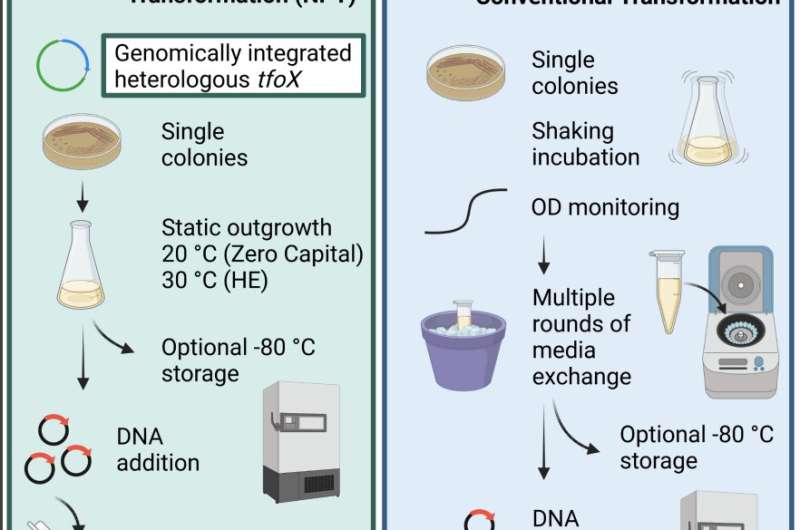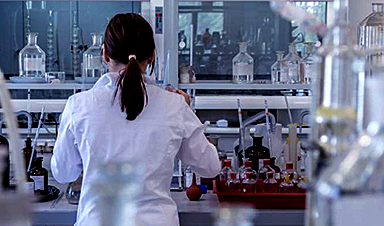Cornell University researchers have created a new version of a microbe to compete economically with E. coli—a bacteria commonly used as a research tool due to its ability to synthesize proteins—to conduct low-cost and scalable synthetic biological experiments.
As an inexpensive multiplier—much like having a photocopier in a test tube—the bacteria Vibrio natriegens could help labs test protein variants for creation of pharmaceuticals, synthetic fuels and sustainable compounds that battle weeds or pests. The microbe can work effectively without costly incubators, shakers or deep freezers and can be engineered within hours.
The research was published Feb. 13 in PNAS Nexus.
“It’s really easy to produce,” said lead author David Specht, a postdoctoral researcher in the laboratory of Buz Barstow, assistant professor of biological and environmental engineering.
To study proteins for creating medical cures or fashioning fuels, researchers use a plasmid (a small piece of DNA) that acts as the instruction manual to make the molecular machine—a protein—of interest. Currently, when researchers place a plasmid into E. coli, they can create many copies to test several variants.

E. coli cells help molecular biologists multiply and manipulate plasmids for protein engineering, but the process is expensive since they often purchase the bacteria from manufacturers, must keep it cold and maintain rooms of expensive equipment to sustain it. A modified E. coli, used for this purpose, is also very fragile.”As scientists, we don’t often know precisely what those regulatory or molecular sequences should be to achieve our goals,” said Barstow. “So, we must test a lot of variants, and Vibrio natriegens allows researchers to scale up that process of testing.”
The microbe V. natriegens is not complicated, Specht said. “It’s so simple to make that someone with limited resources—like high school labs, home inventors or startup biological businesses—can do it,” he said.
Researcher Timothy Sheppard compared the simplicity of V. natriegens in conducting synthetic and molecular experiments to using a simple writing instrument hundreds of years old. “We’ve found nature’s pencil for cloning and conducting synthetic biology,” he said.
The process is inexpensive with V. natriegens, as it requires no capital equipment purchases and it can work at room temperature. The cells produced from V. natriegens grow quickly: According to the paper, a transformation started at 9 a.m. yields visible colonies by 5 p.m., each filled with masses of proteins.
“The microbe is a radically simple solution to a hard problem,” Barstow said.
More information: Efficient Natural Plasmid Transformation of Vibrio natriegens Enables Zero-capital Molecular Biology, PNAS Nexus (2024). DOI: 10.1093/pnasnexus/pgad444
Provided by Cornell University
News
Gold Nanoclusters Could Supercharge Quantum Computers
Researchers found that gold “super atoms” can behave like the atoms in top-tier quantum systems—only far easier to scale. These tiny clusters can be customized at the molecular level, offering a powerful, tunable foundation [...]
A single shot of HPV vaccine may be enough to fight cervical cancer, study finds
WASHINGTON -- A single HPV vaccination appears just as effective as two doses at preventing the viral infection that causes cervical cancer, researchers reported Wednesday. HPV, or human papillomavirus, is very common and spread [...]
New technique overcomes technological barrier in 3D brain imaging
Scientists at the Swiss Light Source SLS have succeeded in mapping a piece of brain tissue in 3D at unprecedented resolution using X-rays, non-destructively. The breakthrough overcomes a long-standing technological barrier that had limited [...]
Scientists Uncover Hidden Blood Pattern in Long COVID
Researchers found persistent microclot and NET structures in Long COVID blood that may explain long-lasting symptoms. Researchers examining Long COVID have identified a structural connection between circulating microclots and neutrophil extracellular traps (NETs). The [...]
This Cellular Trick Helps Cancer Spread, but Could Also Stop It
Groups of normal cbiells can sense far into their surroundings, helping explain cancer cell migration. Understanding this ability could lead to new ways to limit tumor spread. The tale of the princess and the [...]
New mRNA therapy targets drug-resistant pneumonia
Bacteria that multiply on surfaces are a major headache in health care when they gain a foothold on, for example, implants or in catheters. Researchers at Chalmers University of Technology in Sweden have found [...]
Current Heart Health Guidelines Are Failing To Catch a Deadly Genetic Killer
New research reveals that standard screening misses most people with a common inherited cholesterol disorder. A Mayo Clinic study reports that current genetic screening guidelines overlook most people who have familial hypercholesterolemia, an inherited disorder that [...]
Scientists Identify the Evolutionary “Purpose” of Consciousness
Summary: Researchers at Ruhr University Bochum explore why consciousness evolved and why different species developed it in distinct ways. By comparing humans with birds, they show that complex awareness may arise through different neural architectures yet [...]
Novel mRNA therapy curbs antibiotic-resistant infections in preclinical lung models
Researchers at the Icahn School of Medicine at Mount Sinai and collaborators have reported early success with a novel mRNA-based therapy designed to combat antibiotic-resistant bacteria. The findings, published in Nature Biotechnology, show that in [...]
New skin-permeable polymer delivers insulin without needles
A breakthrough zwitterionic polymer slips through the skin’s toughest barriers, carrying insulin deep into tissue and normalizing blood sugar, offering patients a painless alternative to daily injections. A recent study published in the journal Nature examines [...]
Multifunctional Nanogels: A Breakthrough in Antibacterial Strategies
Antibiotic resistance is a growing concern - from human health to crop survival. A new study successfully uses nanogels to target and almost entirely inhibit the bacteria P. Aeruginosa. Recently published in Angewandte Chemie, the study [...]
Nanoflowers rejuvenate old and damaged human cells by replacing their mitochondria
Biomedical researchers at Texas A&M University may have discovered a way to stop or even reverse the decline of cellular energy production—a finding that could have revolutionary effects across medicine. Dr. Akhilesh K. Gaharwar [...]
The Stunning New Push to Protect the Invisible 99% of Life
Scientists worldwide have joined forces to build the first-ever roadmap for conserving Earth’s vast invisible majority—microbes. Their new IUCN Specialist Group reframes conservation by elevating microbial life to the same urgency as plants and [...]
Scientists Find a Way to Help the Brain Clear Alzheimer’s Plaques Naturally
Scientists have discovered that the brain may have a built-in way to fight Alzheimer’s. By activating a protein called Sox9, researchers were able to switch on star-shaped brain cells known as astrocytes and turn them into [...]
Vision can be rebooted in adults with amblyopia, study suggests
Temporarily anesthetizing the retina briefly reverts the activity of the visual system to that observed in early development and enables growth of responses to the amblyopic eye, new research shows. In the common vision [...]
Ultrasound-activated Nanoparticles Kill Liver Cancer and Activate Immune System
A new ultrasound-guided nanotherapy wipes out liver tumors while training the immune system to keep them from coming back. The study, published in Nano Today, introduces a biodegradable nanoparticle system that combines sonodynamic therapy and cell [...]





















